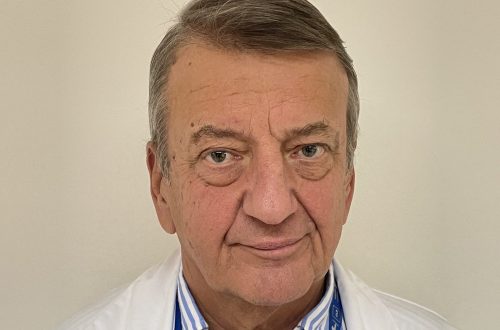Congress Newsletter 2023
Thoughts on the Prof. Ibsen Lecture: Past, Present, and Future of Intensive Care Medicine
Intensive care medicine has evolved significantly over the past decades, transforming the way critically ill patients are treated and improving their outcomes. However, the switch to sustainable development must be accelerated in medical settings, as hospitals are the primary emitters of carbon dioxide and other greenhouse gases in the medical sector. In fact, intensive care units (ICUs) produce three times more greenhouse gas emissions per bed day compared to acute care units [Prasad et al., 2022].
In terms of sustainable development practices, it is encouraging to note that 40% of 153 intensive care units in Australia and 65% of 20 intensive care units in New Zealand had a medical professional or a group responsible for evaluating and executing sustainable development plans in the year 2020–2021. This marks an increase from 36% and 48%, respectively, in the previous year [Trent, 2022].
Sustainable development teams play a crucial role in promoting unit-level shifts and raising awareness about individual steps towards sustainability. In addition, they act as a conduit between healthcare workers, management, and professionals, facilitating the implementation of green initiatives [Seifert, 2018; Krüger et al., 2017]. Moreover, these teams provide legitimacy and permanence to sustainable development efforts [Seifert, 2018].
Notably, there is growing evidence that sustainable development teams can utilize data collection and monitoring techniques, such as life cycle assessment (LCA) evaluations, to identify opportunities for improved sustainability. LCAs, also known as bottom-up analyses, have been employed in numerous research projects to evaluate the environmental impact of processes involving natural resource extraction, including production, packaging, transportation, utilization, reuse, and recycling or waste disposal for specific items and procedures [McGain et al., 2020].
According to a report from England [Bein, 2023], each ICU patient consumes approximately 15 kilowatt-hours of electricity daily, primarily for medical services and patient monitoring. This energy usage is comparable to that of a typical four-person family on a daily basis.
Administering medications is a crucial component of intensive care. LCAs for medications encompass the entire life cycle, from collecting raw ingredients to extending through production, packaging, and transportation to the ICU. However, it is important to note that regional variables, such as local energy, transportation costs, and salary levels, among other factors, can influence these analyses.
Initiating practical steps is essential to urgently reduce carbon footprints. Transitioning to renewable energy sources, reducing energy consumption, and minimizing the immediate release of greenhouse gases through alternative options are some of the steps that can be taken to mitigate emissions.
The foundation of critical care studies has traditionally relied on local and national study systems. However, the aftermath of the COVID-19 pandemic has witnessed the emergence of international study platforms and networks [Esper, 2022]. This global approach, encompassing both high-resource and low-resource settings, has the potential to enhance inclusivity, diversity, and equity for researchers and their subjects, with a particular focus on conducting studies in areas of greatest need.
Following a period of unrestricted implementation of the intensivist’s “armamentarium,” there has been a recent prominence of a “decide prudently” action or the adoption of a “less is more” approach. This approach involves regularly considering beneficial initiatives that align with recommendations, reasonable therapeutic objectives, and the patient’s wishes [Auriemma et al., 2019].
Currently, meticulous and responsible care of ICU patients can incorporate a sustainable development lens. Despite this, quantifying the amount of waste generated by ICUs has not been thoroughly studied, even though approximately 50% of it may be recyclable. Therefore, it is important to keep in mind the waste disposal adage: “Reduce waste first, reuse where probable, and recycle if everything else fails.”
Bein [2023] states that results from LCAs are often absent or inconsistent with each other for specific processes or products, particularly when comparing disposable and reusable/multi-use products. Thus, to dispose of necessary supplies sustainably, manufacturing companies, the medical community, and users should engage in discussions about the regular consumption of single-use products.
Although waste production in critical care is currently unavoidable, implementing waste management initiatives to promote efficient supply usage and involving intensivists in hospital product assessment committees are crucial steps towards reducing carbon footprints [McAlister et al., 2016].
The “5R” concept, which includes “reduce, reuse, recycle, rethink, and research,” has become a subject of significant debate and study [Schuster et al., 2020]. Furthermore, advancing remote discussions, integrating telemedicine, and live broadcasting local or international conferences can serve as effective alternatives to reduce travel by plane, car, or train, which contributes to carbon emissions.
In an intensive care unit with 14 beds in Melbourne, Australia, the installation of recycling facilities resulted in diverting 5 tonnes of waste from landfills annually. In addition, proper waste management in an intensive care unit with 41 beds in São Paulo, Brazil, improved by 32.3% due to changes in healthcare procedures and staff training. Similarly, in a 16-bed intensive care unit in Canada, there was an 80% decrease in the total quantity of unused supplies waste as a result of improvements in supply stocks [Yu & Baharmand, 2021].
Significant disparities in critical care availability globally reflect inequalities between developed nations that overspend on ICU facilities (resulting in a larger carbon footprint) and developing nations with a higher prevalence of critical illness but insufficient care facilities [Bein, 2023]. Eliminating these disparities may be a prerequisite for aiming towards a sustainable future. Achieving this requires new forms of collective management [MacNeill et al., 2021], inclusiveness, constructive deliberation, and inspired action from individuals involved in every step of healthcare, including policymakers, professional organisations, hospital administrators, and ICU personnel.
In the coming years, the ICU setting will reduce the risks of post-intensive care syndrome for patients and their families [Mikkelsen et al., 2020]. This setting will address patients’ and their families’ physical and psychological needs. Wearable technology and home-based rehabilitation programs will make identifying and treating such conditions easier [Major et al., 2021]. ICU designs in the future will distinguish between medical and non-clinical spaces to better incorporate humanistic elements. The ideal environment will maximise the physical, psychological, and cognitive health of patients, their family members, and the critical care team.
To protect patient health and well-being in the future, there should be greater transparency and reliability regarding data safety, confidentiality, and exchange. Patients, families, medical professionals, scholars, executives, health policy organisations, authorities, and regulatory bodies must collaborate to develop these measures [Sabin, 2021].
ICU teams dedicated to sustainable development are crucial for utilising employee skills, inspiring innovation, and identifying new and improved transition strategies. Critical care medicine must join the effort to move towards emission-free hospitals as soon as possible.
References
- Auriemma, C. M., van den Berghe, G., Halpern, S. (2019). Less is more in critical care is supported by evidence-based medicine. Intensive Care Medicine 45,1806-1809.
- Bein, T., & McGain, F. (2023). Climate responsibilities in intensive care medicine—let’s go green! An introduction to a new series in intensive care medicine. Intensive Care Medicine 49(1), 62-64.
- Esper, A. M., Arabi, Y. M., Cecconi, M., Du, B., Giamarellos-Bourboulis, E. J., Juffermans, N., … & Martin, G. S. (2022). Systematized and efficient: organization of critical care in the future. Critical Care 26(1), 1-7.
- Krüger J., Araújo C., & Curi G. (2017). Motivating factors in hospital environmental management programs: a multiple case study in four private Brazilian hospitals TT – Factores motivadores de los programas de gestión ambiental en hospitales: un estudio de caso múltiple en cuatro hospitales pr. Cadernos EBAPEBR 15, 496-510. https://doi.org/10.1590/1679-395160285
- MacNeill A., McGain F., & Sherman J. (2021). Planetary health care: a framework for sustainable health systems. Lancet Planet Health 5, e66-e68.
- Major, M. E., Dettling-Ihnenfeldt, D., Ramaekers, S. P. J., et al. (2021). Feasibility of a home-based interdisciplinary rehabilitation program for patients with post-intensive care syndrome: The REACH study. Critical Care 25, 279.
- McAlister, S., Ou, Y., Nef, E., Hapgood, K., Story, D., Mealey, P., McGain, F. (2016). The environmental footprint of morphine: a life cycle assessment from opium poppy farming to the packaged drug. BMJ Open 6(10), e013302.
- McGain, F., Muret, J., Lawson, C., Sherman, J. D. (2020). Environmental sustainability in anaesthesia and critical care. Br J Anaesth 125, 680-692.
- Mikkelsen, M. E., Still, M., Anderson, B.J., et al. (2020). Society of Critical Care Medicine’s international consensus conference on prediction and identification of long-term impairments after critical illness. Crit Care Med 48, 1670-1679.
- Prasad P. A., Joshi D., Lighter J., Agins J., Allen R., Collins M., Pena F., Velletri J., Thiel C. (2022). Environmental footprint of regular and intensive inpatient care in a large US hospital. Int J Life Cycle Assess 27, 38-49. https://doi.org/10.1007/s11367-021-01998-8
- Sabin S. (October 4, 2021). Hospital ransomware attacks now have deadly consequences. Politico. Available at: https://www.politico.com/newsletters/weekly-cybersecurity/2021/10/04/hospital-ransomware-attacks-now-have-deadly-consequences-798002
- Schuster, M., Richter, H., Pecher, S., Koch, S., & Coburn, M. (2020). Ecological sustainability in anesthesiology and intensive care medicine. A DGAI and BDA position paper with specific recommendations. Anaesth Intensivmed 61,329-338.
- Seifert C. (2018). The barriers for voluntary environmental management systems—the case of EMAS in hospitals. Sustainability 10(5), 103390/su10051420. https://doi.org/10.3390/su10051420
- Trent, L., Law, J., & Grimaldi, D. (2023). Create intensive care green teams, there is no time to waste. Intensive Care Medicine, 1-4.
- Yu, A., & Baharmand I. (2021). Environmental sustainability in Canadian critical care: a nationwide survey study on medical waste management. Healthcare Quarterly 23(4), 39-45. https://doi.org/10.12927/hcq.2020.26394










